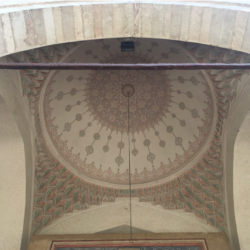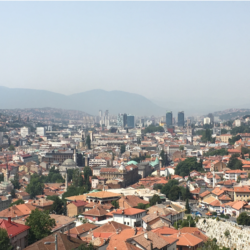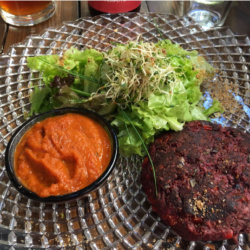
One of the great joys of solo, independent travel is that you’re not on anyone else’s schedule. You can do what you, when you want; travel at your own pace and plan your activities accordingly. While solo travel may seem scary at first, once you taste this freedom, you may not be able to go back. It therefore can be difficult give up that sweet total control and admit there are a few things best left for someone else to organize. Sometimes our pride gets in the way and we feel that we’ve somehow failed if we hire a guide for the afternoon or sign up for a morning tour. You’re out there in the world, proving you can do anything and now you’re admitting defeat.
Well, throw those thoughts right out the window!
Don’t cut off your nose to spite your face. By not hiring that guide to take you up the mountain or taking the tour of the underground communist bunker, you will only be hurting yourself by missing out on great experiences, which often are enriched by a guide’s expertise and enthusiasm. I’m still likely to do my own thing 95% of the time, but giving up control can yield impressive results. Case in point: Sarajevo Funky Tours (http://www.sarajevofunkytours.com/en.html) and their “Total Siege Tour.”
I had spent a decent amount of time in Sarajevo’s numerous historical museums and was beginning to understand what happened during the siege (and the Yugoslav War of the 1990’s), but was much less clear on the why. I also wanted to get out to The Tunnel Museum, which is located on the edge of Sarajevo, right past the airport; the former Olympic bobsled track was equally high on my list to visit, but it’s even further outside town in the opposite direction. After a little research I came across Sarajevo Funky Tours and their tour offering stops at both the museum and the bobsled track, as well as the promise to thoroughly explain the background of the conflict.
My guide, Arna (I believe I got down the correct spelling), was absolutely wonderful. She lived through the siege and answered questions to my heart’s content. I truly received a detailed oral history of the political machinations of Yugoslavia/Bosnia and Herzegovina/Sarajevo post-WWII to the present. To begin to have any understanding of the region you have to learn to separate ethnicity from nationality. This was difficult for me and perhaps will be for other Americans. In the U.S., it doesn’t matter if your ancestors are from Germany, Mexico, Ghana or Cambodia. If you were born here, you are an American- and that’s American first and foremost. Phrases like “For God and Country” and quotes like JFK’s “Ask not what your country can do for you- ask what you can do for your country,” are drilled into us at an early age. You might be ___________ – American, but it is the “American” that is the most important part.
That’s not necessarily the case in The Balkans. You hear the words Serb/Serbian, Croat/Croatian and Bosniak/Bosnian and think they may mean the same thing, but they don’t. Bosniak signifies an ethnic group; Bosnian is used to label citizenship or language. I was told that on your birth certificate you are labeled by your nationality AND ethnicity. You can be a Serb born in Bosnia (Bosnian Serb) or a Croat born in Serbia (Serbian Croat), and it is the ethnicity, not the nationality, that often takes precedence when defining your identity. You could be from a Serb family that has had generations and generations born in Bosnia and still consider yourself a Serb first and Bosnian second. Because of this, Bosnia and Herzegovina, along with the Serb Republika Srpska, are in actuality more like three nations under one internationally recognized label. There are even three presidents(!), one from each ethnic group. It’s a lot to wrap your head around, and all the more reason I found it fulfilling to discuss everything with someone who could help me sort out the bits and pieces I had picked up already.
My tour group was small- only five people, including myself- and that helped keep things intimate. The last thing I wanted was to be stuck in a tour group with 20-30 people and feel like I was a mere sheep being shepherded to and fro. We hopped into a van and received some background information on the siege as we traveled out to The Tunnel Museum. On March 1, 1992, Bosnia and Herzegovina declared independence from Yugoslavia; Macedonia, Slovenia and Croatia had recently done the same. The Bosnian Serbs, lead by the Army of Republika Srpska surrounded the city and formed a blockade, preventing supplies and people from entering or leaving Sarajevo. The siege officially began on April 5, 1992 and lasted nearly four years until February 29, 1996. An estimated 14,000 people died during the siege; nearly 5,500 of whom where civilians.
In order to transport food, supplies and people between the city and Bosniak-held territory outside of Sarajevo, a group of workers dug a 100 meter tunnel connecting the two areas. The tunnel was dug completely by hand, with the dirt carried out in wheelbarrows. They started digging at both ends and completed the tunnel by meeting in the middle. The tunnel frequently flooded and at first it was merely a muddy passageway, although it was later reinforced with a railway cart track. Today, only a 25 meter portion of the tunnel remains, but you can walk through it and visit the museum paying tribute to those who lost their lives managing the tunnel.




The tunnel, commonly dubbed “The Tunnel of Hope,” was the only lifeline the citizens of Sarajevo had with the outside world. While many of the other regions of Bosnia and Herzegovina fell to the Serb army, Sarajevo never was captured. The buildings of the city did suffer immense damage from machine gun fire and shelling. Many have been restored, but there are still plenty of scars to be seen.
After The Tunnel Museum, we drove into Republika Srpska and up Trebević, the mountain directly southeast of Sarajevo where the Olympic bobsled track is located. The sides of the track have been brightly spray painted and it truly was one of the more surreal moments of my life being able to walk done a former Olympic track. The views of Sarajevo were also breathtaking.
Here’s a virtual walk down the track:




Taking in the city from above:


Our last stop was to a former hotel and restaurant used by the Srpska Army during the siege. What was once a well-kept mountain retreat has been left in ruin.


The weather had been gorgeous all day, but as soon as we got off the bobsled track it looked like it was going to rain. As the storm clouds rolled in I was able to snap what I think is my favorite photo of my time in Sarajevo: throughout all the darkness in recent years the sun is bursting through like a ray of hope you’d find in a Renaissance painting. After all the atrocities, the city and nation(s) really seem to be pulling through together in a peaceful way. As my guide explained, politicians still attempt to stoke the flames of ethnic tension during election cycles, but that most average citizens simply want to move onwards and upwards to better days.



